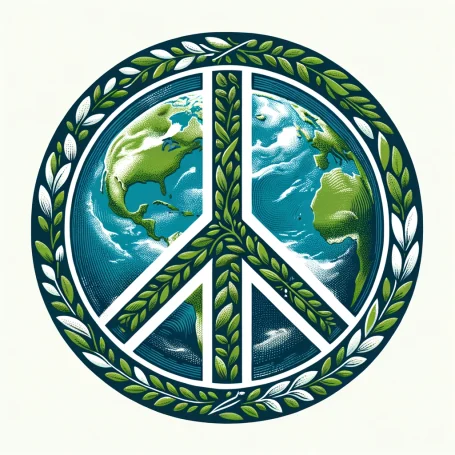May Earthpeace be with you!
The Sun's Last Symphony
The Sun expands, its flames arise,
A burning giant in crimson skies.
The Boem unravels, its bonds undone,
Its planets waltz from their dying Sun.
Planet Earth burns in the Sun’s embrace,
Its oceans vanish without a trace.
Mountains melt, their peaks descend,
A world consumed, its story at end.
Jupiter floats, its storm grown still,
Saturn’s rings fade, their light turns chill.
Neptune and Uranus slip through the deep,
Bound to the void where shadows sleep.
The comets stray, the asteroids spread,
Fragments adrift where the Sun once led.
The Boem falls silent, its warmth no more,
Its echoes fade to the cosmic shore.
Yet from its end, a spark will rise,
A nebula bright in the endless skies.
New stars will form where the old ones rest,
A universe stirred, its future blessed.
Across the stars, we find our place,
On distant worlds in endless space.
From Planet Earth’s own ashes, dreams ignite,
To light the void with eternal light.
The Sun’s farewell, its glow persists,
Its essence remains where the cosmos twists.
The Boem may fade, its star may rest,
But its story lives in hearts professed.
We carry its dreams to distant lands,
Through alien soil and foreign sands.
On worlds unknown, we plant its flame,
Its light reborn to guide our claim.
The End of the Boem
The End of the Boem
The Moment the Sun Fades
Around March, 5,000,002,124 CE, our Sun, our ancient and steadfast companion—will enter its final phase as a star. For billions of years, it has been the heart of the Boem, our Solar System, a cosmic symphony of planets, moons, and asteroids orchestrated around its luminous warmth. But now, that symphony will draw to a close. The Sun will swell into a red giant, its fiery embrace expanding far beyond its current reach, consuming the entire Boem in an irreversible inferno.
The Boem, once vibrant with the dance of celestial bodies in harmonious orbits, will unravel into silence. The Sun’s gravitational grip will falter, and the outer planets, untouched by its flames but orphaned from its life-giving light, will drift further into the cold abyss of interstellar space. What was once a thriving system, teeming with life and the echoes of humankind’s beginnings, will become a graveyard of worlds.
On Planet Earth, the implications of this event will have been known for eons. Long before the Sun's final act, the planet will have been stripped of its ability to sustain life. Its oceans, evaporated. Its atmosphere, scorched and scattered into the void. Its continents, fractured and barren. What remains will be a lifeless husk, spinning silently in the Sun’s deadly glow—a reminder of what once was.
The Boem’s Last Days
As the Sun begins its transformation into a red giant, the skies above Planet Earth will dim and change. Its once golden rays will shift to a blood-red hue, casting long shadows across its desolate surface. The Sun will appear larger each day, a bloated, throbbing orb, its surface boiling with the energy of its final breaths.
Planet Earth, no longer the vibrant blue-green sphere that cradled humankind’s evolution, will face its ultimate demise. The searing heat will melt its crust, reducing its mountains to molten rivers and its plains to glowing seas of magma. The tectonic plates will buckle and shift violently as the planet's core overheats, releasing its last vestiges of energy in volcanic eruptions and earthquakes.
For millions of years, Planet Earth will endure this torment, its surface reshaped by the Sun’s fury. Eventually, the Sun’s expanding outer layers will reach out and claim the planet entirely. It will dissolve into the stellar fire, its atoms scattering into the boiling plasma that now defines the Boem.
The Implications for Humankind
Humankind will have left Planet Earth long before this fiery end. By necessity, our species will have become wanderers of the stars, carrying with us the memory of the Boem and the cradle that nurtured us. The departure will not have been born of despair but of determination—a shared realization that survival requires transcendence, and existence demands adaptation.
In the centuries leading up to this moment, humankind will have prepared meticulously. We will have built the great Celestial Arks, vast ships designed to carry not just our bodies but our cultures, our histories, and the essence of Planet Earth. These ships will have borne us to new homes—some within the Boem and others light-years away, in star systems where we planted the seeds of life anew.
Settling New Worlds
On Proxima Centauri b, the nearest exoplanetary neighbor, humankind will have built cities beneath crimson suns. On the icy oceans of Trappist-1e, we will have created floating metropolises powered by fusion and sustained by ecosystems derived from the DNA of Earth’s flora and fauna. Beyond even these, we will have reached further, to Kepler-452b and other planets orbiting stars that promise stability for eons to come.
These new worlds will not replace Planet Earth. They cannot. But they will be extensions of it—new chapters in the story of humankind, written on alien soil beneath unfamiliar skies.
The End of the Boem
After the Sun expels its outer layers, forming a planetary nebula, its core will collapse into a dense white dwarf. This faint stellar remnant will no longer produce the light or heat that once sustained the Solar System. Instead, it will emit a weak, dim glow, gradually cooling over trillions of years.
The Boem, once a thriving system of interconnected celestial bodies, will become a sparse and lonely expanse. The outer planets, asteroid fragments, and comets will either drift further into the dark void or settle into their new orbits around the cooling white dwarf. The once-vibrant Solar System will no longer be a dynamic system but a fading memory—a cloud of remnants marking the passing of its central star.
The Legacy of Planet Earth
Even as Planet Earth succumbs to the Sun’s flames, its story will endure. Across the galaxy, in the cities we build on distant planets and the starships we pilot through the void, the memory of Planet Earth will be enshrined. On anniversaries of its demise, we will gather in reverence, projecting its image onto the skies of our new homes, singing songs of the rivers and forests, the mountains and oceans that shaped our ancestors.
We will teach our children about the Boem—the Solar System where life began—and about the Sun, whose warmth birthed civilizations before consuming its worlds. The legacy of Planet Earth will not be forgotten. It will live on in our hearts, our stories, and the very fabric of the lives we create in the cosmos.
A New Symphony
Though the Boem ends, it is not truly lost. The atoms forged in the Sun’s core and scattered by its death will become the seeds of new stars and planets. The elements that once formed Planet Earth will drift through the galaxy, coalescing in nebulae, birthing new systems and perhaps new life.
Humankind, now spread across the stars, will look back not with sorrow but with gratitude. The Boem was our beginning, the Sun our first light. Its end is not a loss but a transformation—a passing of the torch from one epoch to the next.
This is the story of the Boem’s final moments, a tale of endings and beginnings, of loss and eternal remembrance.
Though the Boem fades, its light will shine forever in the cosmos and in the hearts of humankind.
Away to Earthpeace
Wir benötigen Ihre Zustimmung zum Laden der Übersetzungen
Wir nutzen einen Drittanbieter-Service, um den Inhalt der Website zu übersetzen, der möglicherweise Daten über Ihre Aktivitäten sammelt. Bitte überprüfen Sie die Details in der Datenschutzerklärung und akzeptieren Sie den Dienst, um die Übersetzungen zu sehen.

